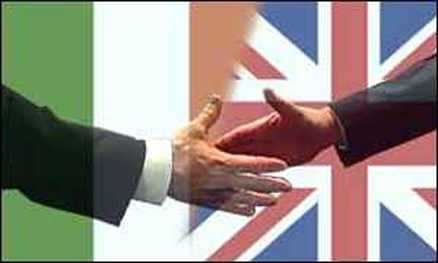On the constitutional question of whether Northern Ireland should remain in the UK or become part of a united Ireland, it was agreed that there would be no change without the consent of the majority. This is called the 'principle of consent'.

The Good Friday Agreement gives prominence to the ‘principle of consent’ which affirms the legitimacy of the aspiration to a United Ireland while recognising the current wish of the majority in Northern Ireland to remain part of the United Kingdom.
It goes on to state that...
“it is for the people of Ireland alone, by agreement between the two parts respectively and without external impediment, to exercise their right of self-determination on the basis of consent, freely and concurrently given, North and South, to bring about a United Ireland, accepting that this right must be achieved and exercised with and subject to the agreement and consent of a majority of the people of Northern Ireland”.

By the mid-1960s the demographic majority that Protestants enjoyed in Northern Ireland ensured that they were able to control the state institutions, and these powers were at times used in ways that disadvantaged the region’s Roman Catholic minority (though the extent of discrimination in Northern Ireland remains a matter of intense debate). An active civil rights movement emerged in the late 1960s, and incidents of communal violence ensued, which led the British government to send troops to assist in quelling the urban violence. Bombings, assassinations, and rioting between Catholics, Protestants, and British police and troops continued into the early 1990s. A tentative cease-fire was called in 1994, but sporadic violence continued.
Multiparty talks—involving representatives of Ireland, various political parties of Northern Ireland, and the British government—resumed in June 1996 and eventually culminated in the signing in Belfaston April 10, 1998 (that year’s Good Friday), of an agreement that called for the establishment of three “strands” of administrative relationships. The first strand provided for the creation of the Northern Ireland Assembly, which would be an elected assembly responsible for most local matters. The second was an institutional arrangement for cross-border cooperation on a range of issues between the governments of Ireland and Northern Ireland. The third called for continued consultation between the British and Irish governments. In a jointly held referendum in Ireland and Northern Ireland on May 22, 1998—the first all-Ireland vote since 1918—the agreement was approved by 94 percent of voters in Ireland and 71 percent in Northern Ireland. However, the wide disparity between Catholic and Protestant support in Northern Ireland (96 percent of Catholics voted in favour of the agreement, but only 52 percent of Protestants did) indicated that efforts to resolve the sectarian conflict would be difficult.